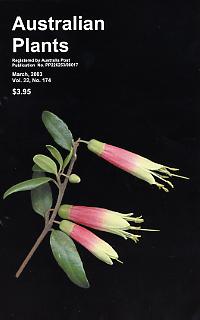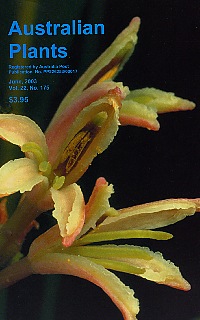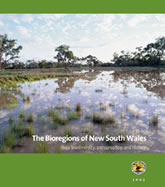|
[Front Page] [Features] [Departments] [Society Home] [Subscribe]

First Cuttings:
News and Views from the World of ASGAP
Australian Plants Societies
Australian Plants online is brought to you by the 7 Societies that make up the Association of Societies for Growing Australian Plants (ASGAP).
Have you ever thought of joining one of the Societies? There is a Regional Society in every Australian state and also in the Australian Capital Territory. In addition, there are over 100 district groups established in centres throughout Australia.
Membership brings many benefits - regular district group and Regional newsletters, the colour journal "Australian Plants", access to free seed banks, regular meetings with expert speakers, bush walks, garden visits, advice from experienced growers, access to difficult to obtain plants and access to Study Groups.
Why not take a look at the Membership Page and see what we have to offer?

The "Gumnuts" Newsletter
Gumnuts is a free email newsletter on Australian native plants which is published 4-6 weekly. It covers a wide range of topics - limited only by the imagination of its subscribers.
To subscribe - please see the "Subscribe" section of the current issue.
You may unsubscribe at any time.

"Flora of Australia" - online
The Flora of Australia project is a major, ongoing task aimed at producing a comprehensive catalogue of the Australian flora. The project commenced in 1981 and will eventually produce a series of 60+ volumes, describes the flowering plants, pines, ferns, mosses, liverworts and lichens to the species level. Around 8,500 taxa have been published so far in the Flora of Australia book series.
In what is probably the most important online resource yet produced on the Australian flora, much of the published work has now been published online - around 4,500 of the 8,500 published taxa (information for over 50 families extracted from the following eleven volumes of the Flora of Australia book series: 3, 11A, 11B, 12, 16, 17A, 17B, 35, 48, 49 and 50).
The Australian Biological Resources Study (ABRS) has developed three web sites to access these taxonomic treatments of Australian plants. One covers the majority of Australia and the other two cover the Oceanic Islands. The sites can be found at:
The Flora of Australia online treatments include the following information:
- citation of selected herbarium specimens
- collection information
- common names where available
- descriptions of the plant (diagnostic)
- distribution information and maps
- flowering and fruiting times
- habitat
- identification keys
- line art and photographs
- plant name, author and year of publication
- reference to further published illustrations
- reference to place of original publication of accepted names and synonyms
- synonyms, doubtful or misapplied names
- type information
Using the search facilities is extremely easy - type in "Banksia" and you get a description of the genus and a key to the species. Type in a known species (eg. "Banksia paludosa") and you go straight to the relevant information for that species.
It's impossible not to be enthusiastic about this initiative. I'm not sure what the policy is for adding additional taxa to the online database - obviously ABRS would like to sell more hard copies of the Flora volumes. Presumably (and hopefully!) additional taxa will be added sometime after publication in hard copy. A table that indicates which of the published volumes are on line can be found here.

ASGAP 2005
In September and October 2005, the Wildflower Society of Western Australia will host the biennial meeting and conference of the Association of Societies for Growing Australian Plants (ASGAP).
 
The Wildflower Society has set up a website to provide information about the conference program and associated pre- and post-conference tours as they are developed. There is already quite a bit of information on the site, including details of the tours that will visit some of the outstanding wildflower areas to the north, east and south of Perth. The conference itself will be held at the Hale School which occupies a campus of 50 ha about 13 km north west of Perth city centre. The school will provide both accommodation and the site for the conference itself.
Pre-conference tours take place from 26 to 30 September, the Conference itself will be held from 1 to 7 October and Post-conference tours follow from 8 to 12 October.
So take a look at the site, mark the dates in your diary and check back regularly to keep up to date on planning.
You can also fill in an "Expression of Interest" form to receive further information as it becomes available.

"Bioregions are relatively large land areas characterised by broad, landscape-scale natural features and environmental processes that influence the functions of entire ecosystems. They capture the large-scale geophysical patterns across Australia. These patterns in the landscape are linked to fauna and flora assemblages and processes at the ecosystem scale, thus providing a useful means for simplifying and reporting on more complex patterns of biodiversity."
This publication by the NSW National Parks and Wildlife Service provides information on the conservation character and significance of the 17 bioregions of NSW which vary considerably in the types of natural values they contain. The bioregions often overlap state boundaries and are:
- Australian Alps NSW, ACT, VIC
- Brigalow Belt South NSW, QLD
- Broken Hill Complex NSW, SA
- Channel Country NSW, QLD, SA
- Cobar Peneplain NSW
- Darling Riverine Plains NSW, QLD
- Mulga Lands NSW, QLD
- Murray Darling Depression NSW, SA, VIC
- Nandewar NSW, QLD
- New England Tableland NSW, QLD
- North Coast NSW, QLD
- South Western Slopes NSW, VIC
- Riverina NSW, VIC
- Simpson-Strzelecki Dunefields NSW, QLD, SA
- South East Corner NSW, VIC
- South Eastern Highlands NSW, ACT, VIC
- Sydney Basin NSW
For each bioregion a range of information is available, including:
- Climate
- Landform
- Biodiversity
- Regional history (including Aboriginal cultural heritage)
- Conservation (how much of this bioregion is protected by parks and reserves)
- Subregions (finer-scale subregions)
- References
- Maps and printable information

How many Megapixels is Enough??
Although this is not a topic directly associated with the Australian flora, many people are entering the world of digital imaging and wanting to apply the new technology to photographing Australian wildflowers.
This article by Ivan Berger helps take some of the mystery out of converting digital images into pictures that can be displayed on a computer screen or converted into photographic enlargements in hard copy. It covers a range of issues such as:
- Just how big an image do you need to produce a quality 8 x 10 enlargement?
- What is the difference between an optical zoom and a digital zoom?
- What are the benefits and disadvantages of different file formats?
If you're new to digital imaging, this article is worth a look.

Hornsby Shire is located north of Sydney and includes extensive reserves of Sydney sandstone flora.
This online herbarium is being compiled by Australian Plants Society, North Shore Group members; Jenny Lewis, Ross Doig, Pat Pike, and Noel Rosten. The Herbarium was begun in 1998 and exists as both a physical collection and an online facility. It currently includes about 750 different native species collected from 59 sites throughout the Shire. Additional specimens will be added to both the physical and website collection as they become available.
The web site consists of:
- a database of information about each plant
- images of the pressed plants,
- images of many of the fresh plants.
Searching the on line database is extremely simple and can be carried out in a number of ways including a search by common name, plant type (eg. fern, shrub, tree, vine etc), botanical name or you can just browse the image gallery.
This is an impressive piece of work and could be the model for similar online databases in other areas. Possibly the only criticism is that it would have been useful if the images in the image gallery could have been directly linked to the text information for the particular species.

"Australian Plants"....in print!
The Society's 48 page, colour (printed) journal, "Australian Plants" has been published quarterly since 1959. It carries articles of interest to both amateur growers and professionals in botany and horticulture. Its authors include the leading professional and amateur researchers working in with the Australian flora and many beautiful and high quality photographs of Australian plants are published in its pages. Topics covered by the journal cover a wide range and include landscaping, growing, botany, propagation and conservation.
A subscription to the print version of "Australian Plants" is $20 annually for 4 issues (overseas $AUS32) including postage. To subscribe, print out the Subscription Form and post or fax the appropriate fee to the address indicated on the form.
Note that the contents of "Australian Plants" and "Australian Plants online"
are totally different.
These are some of the topics covered in recent issues of "Australian Plants":
 |
Issue 174: March 2003
Contents
The Correa Study Group
The Correa Lover and the Artist
Correas Make for Happy Memories
Katandra Gardens - A Home for Correas
Nangawooka - Land of Springs
Botanical List of Correa Species and Varieties
Descriptions of the Species, Varieties and Cultivars
Grafting Correa
Correas as Potted Colour |
 |
Issue 175: June 2003
Contents
Bringing it Back - The Shortland Wetlands story
Alec Blombery's Legacy
Rhododendron lochiae renamed
Book Review: A Hew Image for Western Australian Plants
The Sub-family Persoonioideae - a detailed review of the genus Persoonia and its relatives
Our Garden Number 40
Persoonia in Cultivation
Domestication of 'Golden Cascade' (Corynanthera flava) |
 |
Issue 176: September 2003
Contents
Platysace Tubers - from the bush to your shopping basket
Artificially Crossed Crinums
How to Make Friends with Clay Soils
Australia's Kangaroo Paws
Eucalypts in the Goldfields
Tomah Treasure - Atkinsonia ligustrina
Melicope elleryana
Bungle Bungles
Success with WA Christmas Tree (Nuytsia floribunda)
Eucalypt Dye as a Potential Stain in Microscopy |
 |
Issue 177: December 2003
Contents
The Wallum - Beerwah through the Seasons
Coppercups: The Genus Pileanthus
Wild Places of North Queensland
Mountain Heaths of Southeast Queensland
Our Garden Number 41
Fighting Threatening Plant Species |

Brian Walters
Editor
[Front Page] [Features] [Departments] [Society Home] [Subscribe]
Australian Plants online - March 2004
Association of Societies for Growing Australian Plants
|












